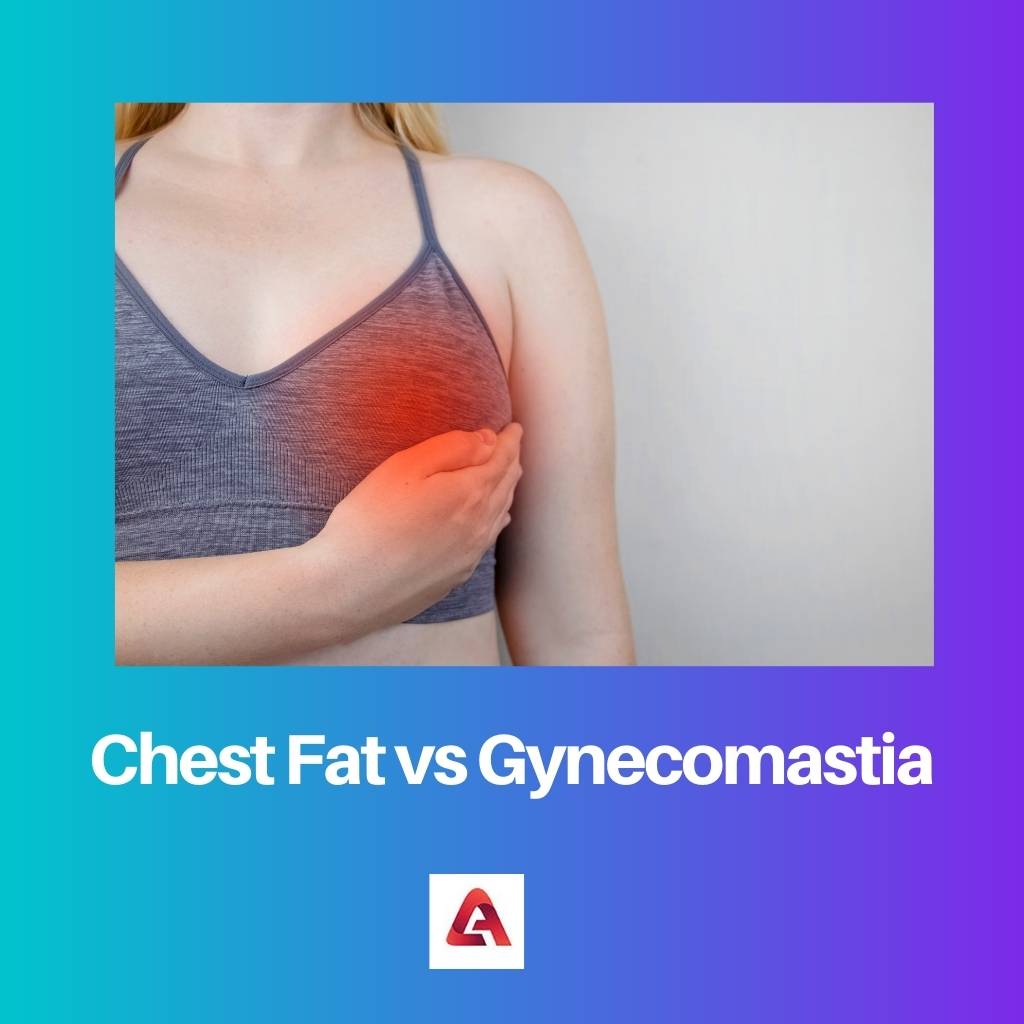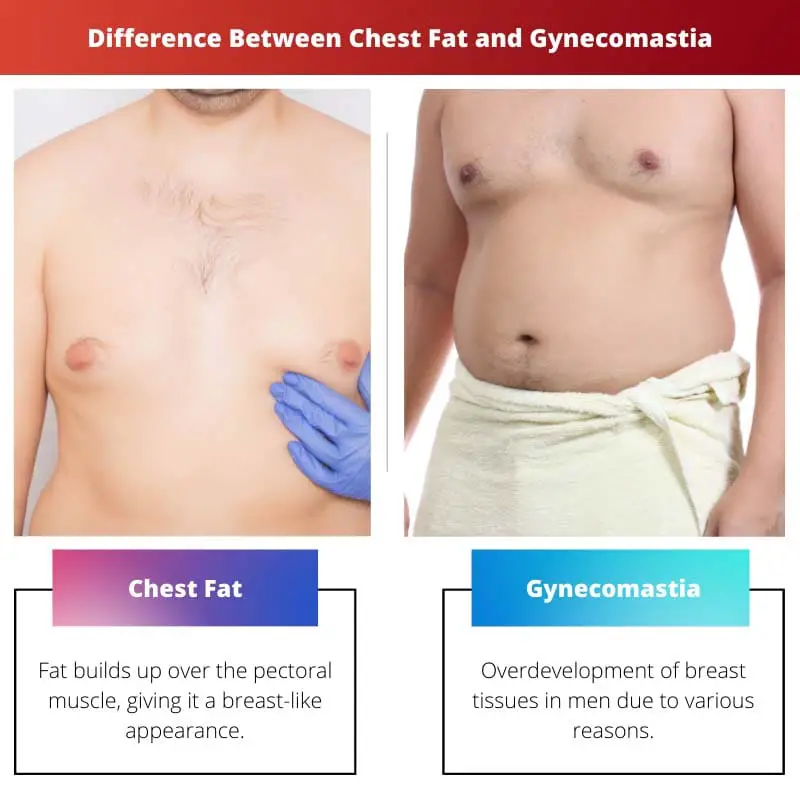An enlargement of the pectoral region in males is more normal than we might think. It affects almost 40-60% of the male population.
It has several different causes, the most common of which is fat buildup above the pectoral muscles or the enlargement of breast tissues in men during puberty.
Key Takeaways
- Chest fat results from excess fatty tissue, whereas gynecomastia involves glandular breast tissue enlargement.
- Gynecomastia can occur due to hormonal imbalances, while chest fat accumulates because of a poor diet and lack of exercise.
- Treatment for chest fat includes exercise and diet changes, while gynecomastia may require medication or surgery.
Chest Fat vs Gynecomastia
The difference between chest fat and gynecomastia is that chest fat is caused by the excess fat formation in the pectoral area, whereas gynecomastia is a condition wherein there is a hormonal imbalance in adolescents going through puberty, which causes the breast tissues to develop more than what is usual in men.

Men, after puberty, can naturally develop fat on their chest due to lack of exercise or because of following a high-calorific and unhealthy diet which causes excess fats to be stored in the adipose tissues of the chest.
When this extra fat isn’t burnt through physical exertion, it builds up and appears as external protrusions.
Gynecomastia, however is a clinical condition recognized by doctors. It is caused by the overdevelopment of breast tissues during puberty or early youth years.
The primary reason for this condition is not known, but in most cases, it occurs due to an estrogen level disbalance in men. When it is produced in excess, it may lead to gynecomastia, also colloquially known as “man boobs”.
Comparison Table
| Parameters of comparison | Chest fat | Gynecomastia |
|---|---|---|
| Cause | Fat builds up over the pectoral muscle, giving it a breast-like appearance. | Overdevelopment of breast tissues in men due to various reasons. |
| Reason of occurrence | Absence of movement or exercise, unhealthy or high calorific diet, or sometimes even genetic. | Happens because of a hormonal imbalance or a side/after effect of medication. |
| Risk | It is unhealthy to have excess fat in one’s body and hence a risk to one’s health. | Benign condition that doesn’t pose any threat to health. |
| Curability | Can be cured through exercise and cutting down calories in one’s diet. | Can’t be cured essentially, but the appearance can be flattened and made to look less prominent |
| Symptoms | Soft fat formation on the chest which doesn’t cause discomfort or pain | A lump or fatty tissue may form under the nipples, sore and uncomfortable. |
What is Chest Fat?
Every human body has its own form of fat distribution. When excess fat deposits over the chest region of males, it starts forming a protruding breast-like structure.
This may simply be genetic or caused by consuming excess calories, which led to fat formation and distribution above the pectoral muscles of males.
Not exercising and giving your body excessive rest may also cause fats to build up in one’s body. Following a calorie-deficit diet, which is a controlled diet that cuts down carbohydrates and fats, can help get rid of the fat.
Exercising and integrating full-body workouts like cardio can also aid in controlling fat formation.
Fat forms when there is an imbalance between the calories we intake and the ones we expend or “burn”. This is why it is extremely important to control our diet and to exercise regularly.
When we consume lesser calories than what we lose, physical movement is when the fat in our body starts being used up for energy, this makes us lose fats successfully and makes us healthier and less prone to diseases.
Chest fat is extremely common, and hence there is no need to worry about it. If a healthy diet and a consistent fitness routine are followed, it can easily be reduced.

What is Gynecomastia?
Gynecomastia is a clinical condition wherein the individual facing it has enlarged and overdeveloped breast tissues. It is not uncommon and affects up to 65% of the male adult population and more than 70% of males going through puberty.
It is also present in newborn babies and can even develop in rarer cases amongst grown men.
It is a non-cancerous disease and hence is quite harmless. The causes, however not well known, can be boiled down to either hormonal imbalance or side effects of certain medications or diseases.
A myth surrounding this condition is that it is somehow related to breast cancer which it is not. However, it is always safe to run tests and assure safety, even though males’ chances of breast cancer are negligible.
It may cause discomfort in the chest along with a lumpy formation. If faced, checking in with a doctor is advised.
It is not entirely curable, but attempts can be made to reduce the protrusion and make it seem flatter by focusing on working on the chest via exercise. This would get rid of any chest fat formation and reduce the size of the breast.
Hormonal treatment and, in rare cases, surgery can also be performed. In the end, it is quite normal and can be left untouched unless it causes discomfort.

Main Difference Between Chest Fat and Gynecomastia
While these two may sound and look similar in nature, they are actually quite different from each other.
- Primarily, the composition of what causes these “man-boobs” to occur is different. In the case of chest fat, it is excess stored fats in the adipose tissues built up in the chest, and in gynecomastia, it is tissues that are overdeveloped due to hormones.
- Estrogen imbalance and medical side effects may cause gynecomastia, however, a stationary and unhealthy life can lead to chest fat.
- Both don’t pose any threat to health, but gynecomastia can sometimes cause discomfort to the person affected.
- Chest fat can be cured if the individual follows a healthy lifestyle, whereas gynecomastia is untreatable unless medical intervention is taken.
- The appearance of the two may vary a bit, too, as the fat collection and the developed breast tissue don’t form the same shape over the pectoral region.

- https://www.nejm.org/doi/full/10.1056/NEJMcp070677
- https://journals.plos.org/plosone/article?id=10.1371/journal.pone.0168932

The detailed comparison table between chest fat and gynecomastia is highly informative. Such content empowers men to make informed decisions about their health.
I couldn’t agree more, Schapman. Articles that outline such comparisons enable individuals to understand these health conditions more thoroughly.
The distinction between chest fat and gynecomastia is well-described in this article. It’s important for men to have access to such informative content to enhance their awareness of these health concerns.
Absolutely, Charlie. Articles like this are instrumental in educating individuals about the nuances of men’s health conditions.
The information provided about gynecomastia is incredibly insightful. Disseminating accurate knowledge about this condition is vital for dispelling misconceptions and promoting understanding.
I completely agree, Hollie. Articles that elucidate gynecomastia contribute to the overall awareness of men’s health concerns.
This article serves as an indispensable resource for raising awareness about gynecomastia. It provides a comprehensive understanding of the condition’s intricacies.
The detailed explanation of gynecomastia provided in this article is very informative. It’s crucial to debunk any myths surrounding this condition to ensure men are well-informed about their health.
I agree. Addressing misconceptions and myths about gynecomastia is essential to promote awareness and understanding of this condition.
The article provides a thorough understanding of chest fat and gynecomastia, helping men distinguish between these conditions. It’s a valuable resource for raising awareness about men’s health concerns.
I couldn’t agree more, Elsie. This article effectively educates readers about the complexities of chest fat and gynecomastia.
I appreciate the comprehensive nature of this article. It’s an excellent reference for individuals looking to learn more about these conditions.
The key differences between chest fat and gynecomastia were well-explained in this article. It’s important for men to be aware of these differences and take appropriate steps to maintain their health.
The comparison of chest fat and gynecomastia in this article is enlightening. It’s important for men to recognize the differences between the two conditions to seek appropriate guidance for their health.
Absolutely, Megan. Understanding the nuances of chest fat and gynecomastia empowers men to take charge of their health proactively.
I found the section on treatment options for these conditions to be particularly helpful. It’s crucial for men to be aware of available interventions for chest fat and gynecomastia.
This article provides valuable insights into the causes and treatment options for chest fat and gynecomastia. It’s essential for men to understand these conditions to make informed decisions about their health.
The comparison table was particularly useful in understanding the differences between chest fat and gynecomastia. It’s a great reference for anyone seeking clarity on these conditions.
I absolutely agree. Men need to be well-informed about these conditions to prevent any misunderstandings or misconceptions about them.
The article effectively educates readers about the differences between chest fat and gynecomastia, providing valuable insights for men’s health awareness.
Indeed, Alexander. Heightening awareness about these conditions contributes to better health outcomes for men.
The section on the causes of chest fat and gynecomastia is exceptionally informative. It’s vital for men to have access to accurate information about these health conditions.
Absolutely, Hadams. Empowering men with knowledge about these factors is pivotal for promoting their well-being.